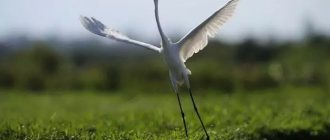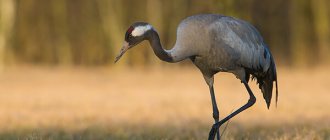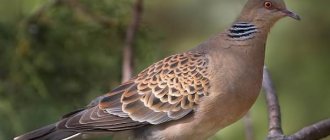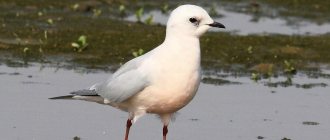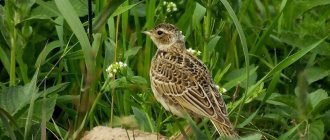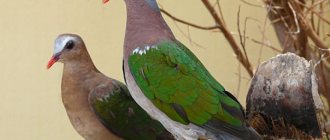- Wild animals
- >>
- Birds
The Japanese crane has been known to children and adults since ancient times. There are many legends and fairy tales about him. The image of this bird has always attracted the attention and interest of people due to its grace, beauty and way of life. The unusual crowing of red-crowned cranes, which changes depending on the situation, also attracts considerable attention. Birds can sing in unison, which is typical for married couples and indicates the right choice of a partner, and also scream loudly and alarmingly in case of danger.
Origin of the species and description
Photo: Red-crowned crane
The Japanese crane (Grus japonensis) has two more names - Manchurian and Ussuri crane. This is a bird from the Crane family that lives in Japan and the Far East. The Japanese crane is a fairly large, strong bird that can be up to 1.5 m in height, with a wingspan of up to 2.5 m and weigh up to 10 kg.
Video: Red-crowned crane
The plumage of cranes is predominantly white. The feathers on the neck are colored black. The wings have a number of black feathers that contrast with the white plumage. The legs of the red-crowned crane are slender, rather high, well adapted for moving through swamps and muddy ground.
Interesting fact: Adults have a kind of cap on their heads - a small area without feathers with red skin, which becomes dark burgundy in winter and during migration.
Male cranes are slightly larger than females, and this is where all the differences between them end. Red-crowned crane chicks are covered with thick, short, dark-colored down. The down on the wings is significantly lighter. Molting in young animals begins in August and lasts almost a year.
The moulted, grown-up young of these birds differ from the adults. For example, the entire head of a chick is covered with feathers, and the rest of the plumage is reddish-brown in color. The lighter the plumage of a red-crowned crane, the more mature it is.
Links[edit]
- ^ B s d e g h BirdLife International 2016. Crane japonensis
. IUCN Red List of Threatened Species 2016: e.T22692167A93339099. https://dx.doi.org/10.2305/IUCN.UK.2016-3.RLTS.T22692167A93339099.en . - ^ ab Archibald GW & Meine, CD 1996. Family Gruidae (cranes)
. In: del Hoyo J, Elliott A, Sargatal J. (Eds.). Hoatzin Auksu. Directory of birds of the world. Vol. 3. pp. 60–89. - del Hoyo, J. Elliott, A. and Sargatal, J. (1996) Handbook of the Birds of the World Volume 3: Hoatzins to Auks Lynx Edicions, Barcelona
- "Archival copy". Archived from the original on January 28, 2012. Retrieved November 27, 2012.CS1 maint: archived copy as title (link)
- "Archival copy". Archived from the original on October 11, 2012. Retrieved December 14, 2013.CS1 maint: archived copy as title (link)
- ^ a b c [1]
- [BirdLife International (2000), Threatened Birds of the World, Lynx Edicions and BirdLife International, Barcelona and Cambridge] Red-crowned Crane - ICF. Archived November 20, 2005, at the Wayback Machine.
- ^ abc CRC Handbook of Avian Body Masses
by John B. Dunning Jr. (editor). CRC Press (1992), ISBN 978-0-8493-4258-5. - ↑
Burnie D and Wilson DE (Eds.),
Animal: The Definitive Visual Guide to the World's Wildlife
. DK for Adults (2005), ISBN 0789477645 - Profile of Wattled Crane (2011).
- Profile of Sarus Crane (2011).
- ^ a b Inoue, M., Shimura, R., Uebayashi, A., Ikoma, S., Iima, H., Sumiyoshi, T., & Masatomi, H. (2013). Body parameters of red-crowned cranes Grus japonensis
by sex and
stage
in eastern Hokkaido, Japan.
Journal of Veterinary Medicine
, 75(8), 1055-1060. - ^ abcd Klenova A.V., Volodin I.A., Volodina E.V. (2008). The structure of the duet provides information about the pairing of the red-crowned crane ( Grus japonensis
).
Journal of Ethology
, 26(3), 317-325. - "Welcome to Cyber Crane". Archived from the original on July 22, 2011. Retrieved May 12, 2008.
- Wildlife Year
, Reader's Digest Association, Inc. (1991). ISBN 0-276-42012-8. - Hongfei, Z., Yining, W., Qingming, W., Xiaodong, G., Meng H., & Jianzhang, M. (2012). Diet composition and preferences of Grus japonensis in Zhalong Nature Reserve during the courtship period [J]
. Journal of Northeastern Forestry University, 6, 021. - ^ abc Britton D. and Hayashida T. 1981. Red-crowned crane: bird of happiness
. Tokyo, New York, San Francisco: Kodansha International. 64 pp. - Klenova A.V., Volodin I.A., and Volodina, E.V. (2007). Vocal development of the red-crowned crane Grus japonensis
. Ornithological Science, 6(2), 107-119. - Carpenter JW. 1986. Cranes (order Gruiformes)
In: Fowler M.E. (Ed.) Zoo and wild animal medicine. Philadelphia, London, Toronto, Mexico City: WB Saunders Company. pp. 316-326. - Ma, Y.C. 1981. Annual cycle of the red-breasted crane
. In: Lewis JC, Masatomi H (Eds.). 1981. Studies of cranes around the world: proceedings of the International Symposium on Cranes, Sapporo, Japan, 1980 and papers of the World Crane Working Group, International Bird Conservation Council. Baraboo, WI: International Crane Foundation. - Ling, Z., Yanzhu, S., Dajun, L. & Yang A. 1998. Plumage growth and molt sequence in red-breasted crane (Grus japonensis) chicks
. In: Cranes in East Asia: Proceedings of a symposium held in Harbin, People's Republic of China, June 9–18. Open report file 01-403. Fort Collins: US Department of the Interior, US Geological Survey. - Klenova A.V., Volodin I.A., Volodina E.V., and Postelny, K. (2010). Voice disturbance in juvenile red-crowned cranes (Grus japonensis)
. Behavior, 147(4), 505-524. - Stott, K. (1948). Notes on the longevity of captive birds. Auk
, 65(3), 402-405. - Jump up
↑ Wang, Z., Li, Z., Beauchamp, G., & Jiang, Z. (2011).
Herd size and human disturbance influence the vigilance of endangered red-crowned cranes ( Grus japonensis
).
Biological Conservation
, 144(1), 101-105. - Winter, S. V. 1981. Nesting on the crane in the Central Amur region. In: Lewis JC, Masatomi H. 1981. Studies of cranes around the world: proceedings of the International Symposium on Cranes, Sapporo, Japan, 1980 and papers of the World Crane Working Group, International Council for the Conservation of Birds
. Baraboo, WI: International Crane Foundation. - USGS. 2006. Cranes: status review and conservation plan: threats: biological factors.
- Bae, S. H., & Won, P. (1994). Wintering ecology of red and white-crowned cranes Grus japonensis and G. vipio in the Cheolwon Basin, Korea
. The future of cranes and wetlands: Proceedings of an international symposium. Wild Bird Society of Japan, Tokyo (pp. 97–196). Chicago. - Lee, S. D., Jablonski, P. G., Higuchi H. 2007. Effects of heterospecific species on the feeding behavior of endangered red-crowned and white-crowned cranes in the Korean Demilitarized Zone. Ecological Research
22: 635-640. - Su, L. and Zou, H. 2012. Status, threats and conservation needs of the continental population of the red-crowned crane. Chinese Birds 3(3):147–164 [2]
- Masatomi Y., Higashi, S. & Masatomi, G. A simple population viability analysis of Tancho (Crane japonensis) in southeastern Hokkaido, Japan. Popul Ecol 49, 297–304 (2007) [3]
- ISIS (2011). Grus japonensis.
Version dated March 28, 2011 - Controversy over the crane's candidacy for national bird status
- Huff, Jerry (2011). Notes on the creation of the Tsurumaru logo
. unpublished: himself. clause 3.
Appearance and features
Photo: What does a red-crowned crane look like?
The Japanese crane is one of the largest among the representatives of its family. This is a rather large, strong and very beautiful bird, one and a half meters tall. The most important distinguishing feature of the Japanese crane from other species is its snow-white plumage with rare splashes of black feathers on the head, neck and wings.
Another distinctive feature is that from the eyes to the back of the head and further along the neck there is a rather wide white stripe, which sharply contrasts with the black feathers on the neck and the pitch-black cornea of the eyes.
Interesting fact: Japanese cranes are considered the cleanest among birds, since they devote all their free time to caring for themselves and their plumage.
The legs of cranes are thin, rather high, with dark gray skin. Sexual dimorphism in these birds is barely pronounced - males differ from females only in their larger sizes.
Young red-crowned cranes differ in appearance from adults. Immediately after hatching, the chicks are covered with red or brown down; a year later (after the first molt), their plumage is a mixture of brown, red, brown and white tones. After another year, young cranes become similar in appearance to adult cranes, but their heads are still covered with feathers.
Where does the Japanese crane live?
Photo: Red-crowned crane in Russia
The range of the birds, which are called Japanese cranes, covers China, Japan and the Far Eastern territories of Russia. In total, Japanese cranes inhabit an area of 84 thousand sq. km.
Based on long-term observations, ornithologists distinguish two groups of red-crowned crane populations:
- island;
- mainland.
The island population of birds lives on the southern part of the Kuril Islands (Russia) and Hokkaido Island (Japan). These places are distinguished by a milder climate and an abundance of food, so the cranes live here permanently and do not fly anywhere in the winter.
The mainland population of cranes lives in the Far Eastern part of Russia, in China (areas bordering Mongolia). With the onset of cold weather, the birds living here move to the central part of the Korean Peninsula or to the south of China, and with the onset of spring they return to their nesting places.
Interesting fact: Red-crowned cranes, which live in the national reserve in Zhalong (China), are considered a separate population. Thanks to the protected status of the territory, the best conditions have been created for them.
Since these birds do not tolerate the human presence of people, they choose wet meadows, swamps and heavily swampy lowlands of large and small rivers as their places of residence, remote from populated areas.
Now you know where the Japanese crane lives. Let's see what he eats.
Interesting facts about the bird
In many cultures, the crane is a symbol of good luck, devotion, and thoughtfulness, and Japanese culture is no exception. In fact, cranes flying across the sky will not leave anyone indifferent.
The crane is a migratory bird, and it is believed that in the spring, returning from warm regions, the crane brings warmth with it, and when flying away in the fall, it says that winter is coming. For the Japanese, the red-headed crane 丹頂鶴 (tancho:zuru) symbolizes prosperity and longevity.
There is even a common expression: “A crane lives a thousand years, a turtle lives ten thousand years,” and it means a wish for long life. As an image or symbol, the crane appears in many traditional Japanese arts.
What does the red-crowned crane eat?
Photo: Dance of red-crowned cranes
Red-crowned cranes are very unpretentious in food; they can feed on both plant and animal foods, that is, everything that they can get.
Plant-based menu:
- algae and other aquatic plants;
- young shoots of rice;
- roots;
- acorns;
- cereal grains.
Animal menu:
- small fish (carp);
- snails;
- frogs;
- crustaceans;
- small reptiles (lizards);
- small water birds;
- large insects (dragonflies).
Cranes can also hunt small rodents and destroy the nests of waterfowl. Red-crowned cranes eat either at dawn early in the morning or in the afternoon. In search of various living creatures, they continually walk through the shallow water with their heads low and carefully looking out for prey. While waiting, the crane can stand motionless for a very long time. If a bird sees something suitable in the grass, for example a frog, then it quickly grabs it with a sharp movement of its beak, rinses it in the water for a while, and only then swallows it.
The diet of young animals consists mainly of large insects, caterpillars and worms. The large amount of protein they contain allows the chicks to grow and develop very quickly. Such a rich and varied diet allows the chicks to quickly grow, develop and in a very short time (3-4 months) reach the size of adults. At this age, young cranes are already quite capable of flying short distances.
Features of character and lifestyle
Photo: Red-crowned crane in flight
Red-crowned cranes are most active in the first half of the day. Birds gather in large groups in places where they can find food for themselves (lowlands and floodplains, swamps, wet meadows) and a sufficient amount of food. As night falls, the cranes fall asleep. They sleep standing in the water on one leg.
During the mating season, cranes divide the habitat into small areas that belong to a separate married couple. Each pair very zealously protects its lands and does not allow other pairs into their territory. With the onset of autumn, when it is time to fly south, it is customary for the cranes of the mainland population to gather in flocks.
Interesting fact: The life of Japanese cranes consists of many rituals that are constantly repeated depending on the life situation.
Ornithologists call these rituals dances. They represent characteristic sound signals and movements. Dances are performed after feeding, before bedtime, during courtship, and during wintering. The main elements of crane dances are bowing, jumping, turning the body and head, and throwing branches and grass up with the beak.
Ornithologists believe that these movements reflect the good mood of the birds, help to form new married couples, and also improve relationships between representatives of different generations. With the onset of winter, the mainland population migrates southward. Cranes fly to warm regions in a wedge formation at an altitude of about 1.5 km above the ground, adhering to warm updrafts. During this flight there may be several stops for rest and feeding.
Social structure and reproduction
Photo: Red-crowned crane chick
Manchurian cranes reach sexual maturity at 3-4 years of age. Birds form monogamous married couples that do not break up throughout their lives. Cranes return to their permanent nesting sites quite early: when the first thaws have just begun.
The breeding season for red-crowned cranes usually begins with a ritual song initiated by the male. He sings melodiously (cools), throwing back his head. After some time, the female joins the male. She tries to repeat the sounds made by her partner. Then the mutual mating dance begins, consisting of multiple pirouettes, jumps, flapping wings, and bows.
Interesting fact: The mating dances of Japanese cranes are the most complex of all members of the Crane family. It is curious that both adult birds and young birds take part in them, as if learning all the necessary skills.
A pair of cranes begins to build their nest in March - April, and the place for it is chosen exclusively by the female. The nesting site is usually a dense thicket of aquatic plants with a clear view of the surrounding area, a nearby water source and a complete absence of human presence. The area of land occupied by one couple can be different - 10 square meters. km., and the distance between nests ranges from 2-4 km. Cranes build their nests from grass, reeds and other aquatic plants. It is oval in shape, flat, up to 1.2 m long, up to 1 m wide, and up to 0.5 m deep.
A clutch of cranes usually contains 2 eggs, while young couples have only one. Both parents incubate the eggs, and after about a month the chicks hatch. Just a couple of days after birth, the chicks can already walk with their parents, who are searching for food. On cold nights, parents keep their babies warm under their wings. Care - feeding, warming - lasts about 3-4 months, and then the chicks become completely independent.
Natural enemies of red-crowned cranes
Photo: Japanese crane from the Red Book
Red-crowned cranes are considered very cautious birds. For this reason, and also because of their large size, they do not have many natural enemies. Having a very wide habitat, these birds also have a very diverse range of enemies. For example, on the mainland they can occasionally be hunted by raccoons, foxes and bears. Sometimes just hatched chicks are attacked by wolves and large flying predators (eagles, golden eagles). However, due to the fact that cranes take their safety and protection of their offspring very seriously and responsibly, predators often leave with nothing.
If a predator or a person suddenly approaches the nest closer than 200 m, the cranes first try to divert attention, gradually moving away from the nest by 15-20 m, waiting, and moving away again. In most cases, the distraction technique works great. Parents return home only after being completely convinced that their nest and offspring are no longer in danger.
Manchurian cranes are safer on the islands than on the mainland. After all, on the islands the number of mammalian predators is small and there is a sufficient amount of food for them in the form of small rodents and smaller birds, which are much easier to hunt.
The Story of Life at the Zoo
Red-crowned cranes have been kept in our zoo since the 70s. When the international crane breeding program began, our first Japanese crane, Zhurka, was sent to the USA, to the International Crane Foundation under the leadership of George Archibald. There she was included in the Guinness Book of Records as the most prolific crane - she had about 40 descendants. But later, since most zoos in the world found themselves in possession of her descendants, it was decided to artificially limit her reproduction. We received three chicks from her - a male and two females. In 1985, we received three young Red-crowned cranes from Korea and were able to form three pairs. One of these pairs once laid 3 eggs in one clutch, whereas large cranes always have a clutch of two eggs. In 1987, one of these pairs began to breed, and in 1996 it was transferred to our zoo nursery. The male became seriously ill from frequent changes of enclosure. He recovered, but was blind in one eye. The female carried him mice (his favorite food) and fed him. In total, this couple produced about 20 children. The second pair was transferred to England. During the reconstruction of the zoo in the 90s, the third pair was first transferred to the Oksky Nature Reserve, and then taken to the zoo nursery. But the male fell ill and, despite long-term treatment, died; The 17-year-old female was left alone. We had a one-year-old chick from another pair of cranes, and we tried to pair it with the remaining middle-aged female. And unexpectedly (although they did not have the usual mating ceremonies - they did not shout in unison, they did not mark the territory) they produced two chicks the next year. Since then, they have successfully reproduced and raised their chicks themselves. For a normal life for a Japanese crane in a zoo, its enclosure must be spacious - from 50 to 100 square meters. meters, with grass or sand surface. A small pool is desirable, as most cranes like to swim, and bushes. The difficulty in keeping cranes is the need to provide such a large enclosure for a pair of birds. During the breeding season, cranes are aggressive towards all living creatures, so cleaning and feeding become a problem; a person cannot enter the enclosure alone. You have to take a shield and a mop, and one of the employees protects the other while he is serving the birds. At the same time, cranes “respect” tall people more, and short ones sometimes take a stick, put a hat on its end and raise it above their heads - the bird becomes “more polite.” Large cranes create permanent pairs. As soon as the pair is formed, it begins to show strong aggression towards other cranes in the aviary, freeing its nesting area from strangers. Couples are stable, but if one of the partners dies, the remaining one calmly accepts the other “spouse.” They do not have “swan” loyalty. The placement of cranes is carried out according to the principle - if there is a male and a female, then we must try to form a pair. Cranes should be planted in the fall, at a minimum of hormonal activity. It is advisable for the birds to sit through the bars (in adjacent enclosures) for some time and get to know each other. When we planted the red-crowned cranes, they sat side by side for about two months, looking at each other through the bars. When they were connected, they immediately began to behave like a married couple. A pair of red-crowned cranes are kept on the zoo's grounds. At first they lived in the crane enclosure near the Transition Bridge, and now they can be seen in outdoor enclosures near the Bird House on the Old Territory. The enclosure always contains dry standard feed, which contains balanced vitamins and proteins. Once a day, a wet mash (fish, sprouted wheat, carrots) is given, to which mixed feed is added to make it crumbly. Every day the cranes receive mice - this is all their food.
Population and species status
Photo: Red-crowned crane
The Japanese crane is considered a very small and endangered species. The reason for this is a sharp reduction in the area of undeveloped land, the rapid expansion of agricultural land, and the construction of dams on large and small rivers. Because of this, the birds simply have nowhere to feed and nest. Another reason that almost led to the complete extinction of these beautiful birds is the centuries-old Japanese hunt for cranes for their feathers. Fortunately, the Japanese are a conscientious nation, so this madness of extermination has long been stopped and the number of cranes in Japan, although slowly, has begun to grow.
Today, the population of Japanese cranes is approximately 2.2 thousand individuals and they are listed in the International Red Book and the Red Book of Russia. Thanks to this, at the end of the 20th century, due to the growth in the number of the species on the island of Hokkaido (Japan), cranes began to gradually move to live on neighboring islands - Kunashir, Sakhalin, Habomai (Russia).
However, it's not all bad. It turned out that red-crowned cranes reproduce well in captivity, so active work is currently underway to restore numbers through the artificial creation of a population.
Interesting fact: Chicks that were raised in captivity and released into a permanent habitat are much more relaxed about the presence of humans. For this reason, they can live and nest in places where wild birds do not live.
Further reading[edit]
- Craft, Lucille. 1999. “Divided by politics, united by flight—can Japan and Russia resolve their differences over the remote Kuril Islands and protect the rare red crane?” Wildlife International
. 29, no. 3:22. - Crane - Paul A. Johnsgaard (2011).
- Hayashida, Tsuneo (October 1983). "The Japanese crane, the bird of happiness." National Geographic
. Vol. 164 no. 4. pp. 542–556. ISSN 0027-9358. OCLC 643483454.

